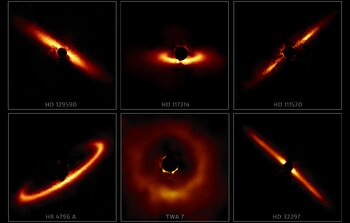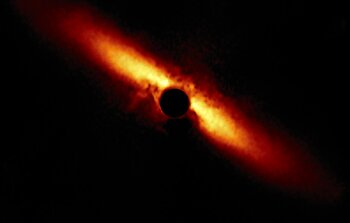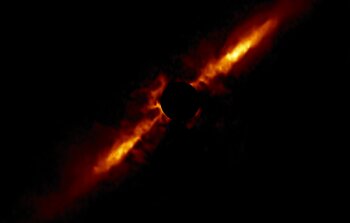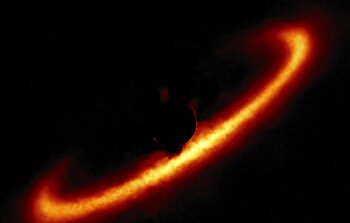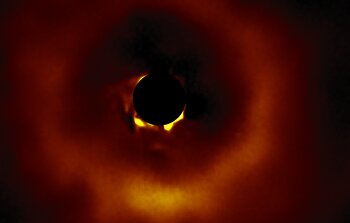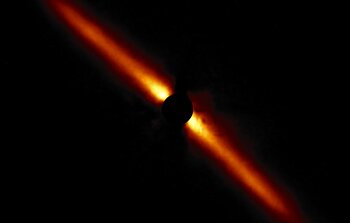Young Planets Bite the Dust
June 24, 2020
Astronomers unveil new collection of planet-forming dusty star systems
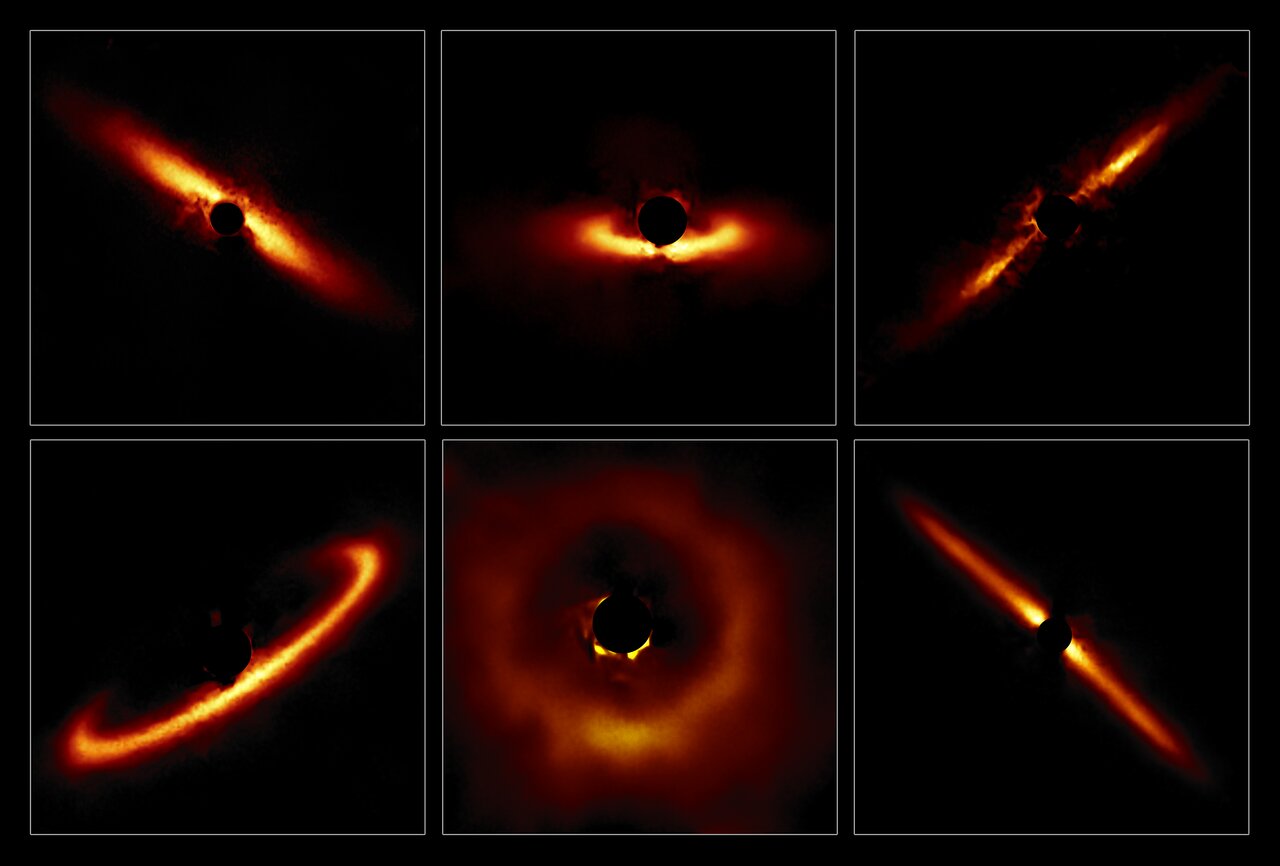
These orange swirls of dust are snapshots from the largest collection of sharp, detailed images of dusty debris disks around young stars — published this week by an international group of astronomers. The images — captured by the 8-meter Gemini South telescope using the Gemini Planet Imager — illustrate the variety of shapes and sizes that stellar systems can take during their infancy. Unexpectedly, the majority of these systems display evidence of planet formation.
These remarkable portraits of dusty disks are a selection from 26 new images of debris disks obtained by the Gemini Planet Imager (GPI) at the international Gemini Observatory, a Program of NSF NOIRLab. These images highlight the diversity of shapes and sizes that these disks can take and show the outer reaches of exoplanetary systems in their formative years. The young stars imaged, which range from tens of millions to a few hundred million years old, are at the ideal age to settle down and raise planets. The forming planets sculpt the dust disk and leave behind gaps and warps that are indirect clues to their existence and motion.
While debris disks have been imaged before, this new cohort of 26 disks represents one of the largest samples to be imaged with highly uniform data quality. This enables detailed comparison of the observations, a unique breakthrough in debris disk surveys. Thirteen of the disks form a perfect natural laboratory, all belonging to the Scorpius–Centaurus stellar association, roughly 400 light-years from Earth. The group of stars, which were born in the same region at roughly the same time, enables astronomers to compare the architectures of a variety of young planetary systems developing under different conditions.
GPI was able to capture these dusty disks with the help of some ingenious astronomical engineering. GPI is sensitive to the polarization of light, allowing it to distinguish dust-scattered light, which is polarized, from the unpolarized light emanating from the stars. This gives GPI the impressive ability to improve the contrast of images and capture disks that are 10 million times fainter than their parent stars. Measuring polarization is only one of GPI’s tricks, however — the instrument also exploits a coronagraph and adaptive optics to get the most from its observations [1][2].
GPI’s precision is in large part due to its perch on the 8-meter Gemini South telescope on Cerro Pachón in Chile. The dry conditions, high altitude, and dark skies are perfect for cutting-edge astronomical research. By combining this exquisite location with some engineering ingenuity, GPI is able to capture images as sharp as those from the Hubble Space Telescope — and detect objects up to three times closer to the host stars [3].
GPI’s first-rate observing abilities enabled this work, part of the Gemini Planet Imager Exoplanet Survey (GPIES), a 4-year search for light emitted by giant gas planets orbiting more than 500 of the youngest stars near the Sun. As well as doubling the number of debris disks imaged at this high resolution, the survey uncovered six giant exoplanets and four brown dwarfs. Surveys such as GPIES are a perfect way to screen targets for the next generation of space- and ground-based telescopes.
“The Gemini instrument program continues to provide unique science opportunities. This combination of GPI mounted upon a large ground-based telescope is delivering exciting new details about the process of how planets form,” said Martin Still, NSF Program Manager for the Gemini Observatory partnership.
The GPIES survey concluded in 2019, but the investment and technical capability of the Gemini Planet Imager will continue with an upgrade to GPI’s hardware to improve its resolution and sensitivity [4]. The new “GPI 2.0,” is slated for a future installation at Gemini North atop Maunakea in Hawai‘i, where it will search the less-observed northern hemisphere skies for more exoplanets and debris disks. GPI 2.0 will also continue the work of scouting out targets for the next generation of exoplanet missions, setting the scene for new insights into the mystery of planet formation.
More Information
This research was presented in the paper Debris Disk Results from the Gemini Planet Imager Exoplanet Survey’s Polarimetric Imaging Campaign in The Astronomical Journal.
The team is composed of Thomas M. Esposito (University of California, Berkeley), Paul Kalas, (University of California, Berkeley, SETI Institute, and Foundation for Research and Technology – Hellas), Michael P. Fitzgerald (University of California, Los Angeles), Maxwell A. Millar-Blanchaer (NASA Hubble Fellow at NASA Jet Propulsion Laboratory), Gaspard Duchêne (University of California,Berkeley and Université Grenoble Alpes), Jennifer Patience (Arizona State University), Justin Hom (Arizona State University), Marshall D. Perrin (Space Telescope Science Institute), Robert J. De Rosa (Kavli Institute for Particle Astrophysics and Cosmology), Eugene Chiang (University of California, Berkeley), Ian Czekala (NASA Hubble Fellowship Program Sagan Fellow at the University of California, Berkeley), Bruce Macintosh (Kavli Institute for Particle Astrophysics and Cosmology), James R. Graham (University of California, Berkeley), Megan Ansdell (University of California, Berkeley), Pauline Arriaga (University of California, Los Angeles), Sebastian Bruzzone (The University of Western Ontario), Joanna Bulger (Pan-STARRS Observatory), Christine H. Chen (Space Telescope Science Institute), Tara Cotton (University of Georgia), Ruobing Dong (University of Victoria), Zachary H. Draper (University of Victoria and National Research Council of Canada), Katherine B. Follette (Amherst College), Li-Wei Hung (University of California, Los Angeles), Ronald Lopez (University of California, Los Angeles), Brenda C. Matthews (National Research Council of Canada and University of Victoria), Johan Mazoyer (NASA Hubble Fellow at NASA Jet Propulsion Laboratory), Stan Metchev (The University of Western Ontario and Stony Brook University), Julien Rameau (Université de Montréal), Bin Ren (Johns Hopkins University and Space Telescope Science Institute), Malena Rice (Yale University), Inseok Song (University of Georgia), Kevin Stahl (University of California, Los Angeles), Jason Wang (California Institute of Technology and University of California, Berkeley), Schuyler Wolff (Leiden University), Ben Zuckerman (University of California, Los Angeles), S. Mark Ammons (Lawrence Livermore National Laboratory), Vanessa P. Bailey (NASA Jet Propulsion Laboratory), Travis Barman (University of Arizona), Jeffrey Chilcote (Kavli Institute for Particle Astrophysics and Cosmology and University of Notre Dame), Rene Doyon (Université de Montréal), Benjamin L. Gerard (University of Victoria and National Research Council of Canada), Stephen J. Goodsell (Gemini Observatory), Alexandra Z. Greenbaum (University of Michigan), Pascale Hibon (Gemini Observatory), Sasha Hinkley (University of Exeter), Patrick Ingraham (Vera C. Rubin Observatory), Quinn Konopacky (University of California San Diego), Jérôme Maire (University of California San Diego), Franck Marchis (SETI Institute), Mark S. Marley (NASA Ames Research Center), Christian Marois (University of Victoria and National Research Council of Canada), Eric L. Nielsen (SETI Institute and Kavli Institute for Particle Astrophysics and Cosmology), Rebecca Oppenheimer (American Museum of Natural History), David Palmer (Lawrence Livermore National Laboratory), Lisa Poyneer (Lawrence Livermore National Laboratory), Laurent Pueyo (Space Telescope Science Institute), Abhijith Rajan (Space Telescope Science Institute), Fredrik T. Rantakyrö (Gemini Observatory), Jean-Baptiste Ruffio (Kavli Institute for Particle Astrophysics and Cosmology), Dmitry Savransky (Cornell University), Adam C. Schneider (Arizona State University), Anand Sivaramakrishnan (Space Telescope Science Institute), Rémi Soummer (Space Telescope Science Institute), Sandrine Thomas (Vera C. Rubin Observatory), and Kimberly Ward-Duong (Amherst College).
NSF NOIRLab (National Optical-Infrared Astronomy Research Laboratory), the US center for ground-based optical-infrared astronomy, operates the international Gemini Observatory (a facility of NSF, NRC–Canada, ANID–Chile, MCTIC–Brazil, MINCyT–Argentina, and KASI–Republic of Korea), Kitt Peak National Observatory (KPNO), Cerro Tololo Inter-American Observatory (CTIO), the Community Science and Data Center (CSDC), and Vera C. Rubin Observatory (in cooperation with DOE’s SLAC National Accelerator Laboratory). It is managed by the Association of Universities for Research in Astronomy (AURA) under a cooperative agreement with NSF and is headquartered in Tucson, Arizona. The astronomical community is honored to have the opportunity to conduct astronomical research on Iolkam Du’ag (Kitt Peak) in Arizona, on Maunakea in Hawaiʻi, and on Cerro Tololo and Cerro Pachón in Chile. We recognize and acknowledge the very significant cultural role and reverence that these sites have to the Tohono O'odham Nation, to the Native Hawaiian community, and to the local communities in Chile, respectively.
Links
Contacts
Peter Michaud
pmichaud@gemini.edu
+1 808-936-6643
NewsTeam Manager
NSF NOIRLab
Gemini Observatory, Hilo HI

